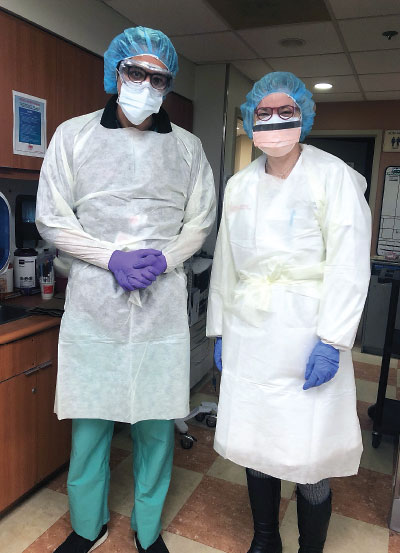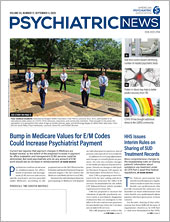Six months into the global COVID-19 pandemic, medical and psychiatric education has changed—in some ways permanently.
Interviews with training directors indicate that institutions, trainees, and faculty have largely adapted to a new world of physical distancing and virtual learning. Didactics are all but entirely virtual now, and institutions have adopted some hybrid of virtual and “traditional” care for patient encounters.
Some of these changes may outlive the pandemic. “I have wanted for a long time to get our residents robust training in telehealth,” said Melissa Arbuckle, M.D., director of adult psychiatry training at Columbia University and president of the American Association of Directors of Psychiatric Residency Training. “I think this is really critical in helping to extend psychiatric care to underserved areas.
“The widespread adoption of telehealth has happened almost overnight—now everyone is doing it,” she continued. “Whenever the situation is normalized, there will be more of a mixture of telehealth and traditional patient care. Right now, our third-year residents are working full time in telehealth—that won’t be the case forever, but I believe telehealth will be a substantial part of their work. That’s a positive change.”
Similarly, the move to virtual didactics has its upside. “More residents are able to participate remotely whether they are at home or on a clinical service off-site. There is more cross-program collaboration now that didactics are virtual, providing more opportunities for partnering, rather than each program doing its own separate didactics.”
Radu Saveanu, M.D., director of psychiatry training at the University of Miami (UM), agreed. “The switch to virtual didactics using Zoom has worked very well,” he said. “There’s a lot of good things about it—attendance is higher than ever, and some residents say they enjoy it more.”
For an educational community, everything is a learning opportunity; the pandemic is no exception, and programs are still learning about what works and what doesn’t.
“With the rapid and largely effective expansion of videoconferencing for clinical care and education, we are starting to develop a sense of what can be effectively done [virtually] without significant loss,” said Katrina DeBonis, M.D., director of psychiatry training at UCLA. “We are also learning where we are missing the connection and interactivity of in-person work such that when it is safe to do so, we will bring back the most valuable types of face-to-face interactions. I imagine that we will be seeing a hybrid model that will allow educators and clinicians to weigh options and choose the format that fits best.”
If medical and psychiatric education is adapting technically and logistically to the new world, the challenge is maintaining morale for the long haul when physical distancing has rendered traditional means of peer support difficult or impossible (see box).
“As a program director, my biggest concern has been the effect on resident wellness, particularly for our junior residents, as we are now in this chronic stage of coping with the pandemic,” DeBonis said.
Lessons Learned From New York
In March and April, COVID-19 arrived as a tsunami that overwhelmed New York City training programs. The crisis has subsided, but the effects of that experience—when many programs in the city had residents deployed to medical or critical care units—lingers.
“Now that we are not in crisis mode, I think residents are still processing that experience,” Arbuckle said. “It was really quite traumatic, particularly for trainees dealing with ethical issues around end-of-life care. Many of our residents were deployed to palliative care and invariably were having discussions with families about end-of-life care, whether to intubate patients, what measures to consider for patients who were dying.”
The experience in New York appears to have served as a warning to institutions elsewhere in the country.
“New York was the testing ground, and we had the luxury of learning from our colleagues there, giving us a lot more time to prepare for an onslaught,” Saveanu said. “That has been incredibly helpful here in Miami. We thought we might see a surge in cases in May, but that didn’t happen. We started seeing a surge at the end of June, and it is ongoing.
“The graduate medical education office [at the UM/Jackson Memorial Hospital] did declare a state of emergency, meaning that residents from specialties could be utilized in other areas. Psychiatry was asked to have a plan, and we did.”
On two occasions in early and mid-July, Saveanu said there were plans to deploy a psychiatry resident to a medical unit; each time the plan was reversed before it became necessary. A unit for psychiatry patients who tested positive for COVID-19 was created at Jackson Behavioral Health Hospital (part of the UM/Jackson Health System). Saveanu said psychiatry trainees have not yet been asked to treat patients on the unit.
Vineeth John, M.D., M.B.A., director of psychiatry training and vice chair of education for psychiatry and behavioral sciences at the University of Texas Health Science Center at Houston, where a statewide midsummer surge in COVID also occurred, described a similar situation. “We were prepared to sign up residents for deployment [to medical units], but it has not come to that point,” he said.
In remarks to Psychiatric News in early August, DeBonis said that at UCLA the surge in cases had not overwhelmed its health care system, so residents from specialties not usually involved in direct medical care did not have to be deployed to care for COVID-19 patients.
She said, “Even with the surge of COVID cases, we haven’t seen a significant change in our day-to-day work. All didactics, supervision, process groups, and lunch conferences are being conducted virtually. Face-to-face learning is limited to rounds on hospital-based services—inpatient wards, consultation-liaison, ER psychiatry.”
DeBonis said UCLA’s first-year residents in the emergency and internal medicine services are caring for COVID-19 patients, as are residents in consultation-liaison psychiatry services.
“Patients are now being seen using a combination of in-person and virtual methods. All patients are tested for COVID prior to admission to the inpatient psychiatric unit.” ■

